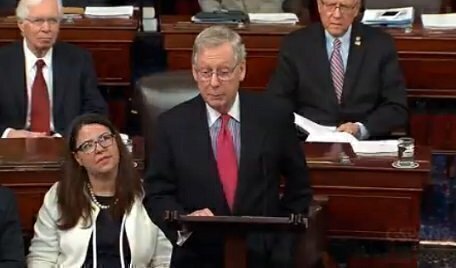A Republican Senate majority killed the chamber’s historic filibuster rule for Supreme Court nominations in a contentious Thursday vote. Earlier, several Democrats joined the Republicans in a failed attempt to invoke cloture and override the filibuster by conventional means.
 Before the first cloture vote, Democratic Senate Minority Leader Chuck Schumer decried the expected move to kill the filibuster for Supreme Court nominees. “I know that in 20, 30, or 40 years we will sadly point to today as a turning point in the history of the Senate and the Supreme Court. This is a day when we irrevocably move away from the principles our founders intended for these institutions," Schumer said.
Before the first cloture vote, Democratic Senate Minority Leader Chuck Schumer decried the expected move to kill the filibuster for Supreme Court nominees. “I know that in 20, 30, or 40 years we will sadly point to today as a turning point in the history of the Senate and the Supreme Court. This is a day when we irrevocably move away from the principles our founders intended for these institutions," Schumer said.
"You know in your hearts of heart that he deserves to be confirmed. And that is why this is an especially sad state of affairs," Senate Judiciary chair Chuck Grassley said before Schumer spoke, referring to nominee Neil Gorsuch.
After the cloture motion was defeated in a 55-45 vote twice, Schumer failed in an attempt to postpone Gorsuch's consideration until April 24. Using a tactic called the Nuclear Option, which was deployed by Harry Reid in 2013, Senate Majority Leader Mitch McConnell made a motion, which could not be appealed, for the full Senate to vote on a point of order he raised, requesting that the Gorsuch nomination go forward with a simple majority vote to limit the debate about his nomination. That motion was approved by a 52-48 vote.
The move clears the way for the full Senate to confirm Gorsuch as the next Supreme Court Justice on Friday, in what is expected to be a mostly party-line vote.
On Monday, the Senate Judiciary Committee voted 11-9 to send a report to the Senate recommending Gorsuch to replace the late Antonin Scalia on the Court. Since then, the Senate has debated the nomination, a process which included a 15-hour speech by Democrat Jeff Merkley from Oregon.
Sign up to receive Constitution Weekly, our email roundup of constitutional news and debate, at bit.ly/constitutionweekly
Last week, Schumer has said he would filibuster the Gorsuch nomination, forcing the Republicans to get 60 votes in the Senate to overcome a cloture motion and move the confirmation to the full floor. McConnell then indicated he would use the procedural move to kill the filibuster process for Supreme Court nominees, leaving just one filibuster process in place for the Senate for legislative votes.
That rule will now likely stand until the next two-year Senate session convenes in January 2019, unless the Democrats regain control of the chamber by some unforeseen circumstances
The Supreme Court filibuster was a rarely used measure in the Senate’s rule arsenal. Schumer’s attempted filibuster was only the fourth (or fifth) mounted against a Supreme Court nominee in modern times.
To this day, there is a debate that tactics used in 1968 to delay the nomination of Associate Justice Abe Fortas as Chief Justice represented a true filibuster. President Lyndon Johnson withdrew that nomination after it had been approved by the Judiciary Committee but delayed in the Senate.
In three other cases, cloture votes were taken in the Senate about a Supreme Court nominee and all failed, in the cases of William Rehnquist (twice) and Samuel Alito.
At the get-go, the odds seemed to be very good for getting a Senate vote on Gorsuch, despite the Democrats’ anger over McConnell’s decision to stall any consideration of Merrick Garland’s nomination last year.
In every instance since 1945 when the same party controlled the White House and the Senate, that Supreme Court nominee has been approved. (There were two nominees in the Lyndon Johnson administration who didn’t make it to the voting stage in the Senate.)
Also since World War II, there have been 38 official nominees for the Supreme Court offered by the President. Eight of those nominations were withdrawn, not voted on or rejected by the Senate. Of the 30 successful confirmations since 1945, 13 of the votes, or about 43 percent, came when the President’s party didn’t control the Senate. This was especially true when the Democrats ran the Senate for long periods during the 1960s and 1970s.
In this case, McConnell clearly indicated in the past week he would use the Nuclear Option, if needed, to get Gorsuch confirmed by this weekend. If Gorsuch is approved, as expected, on Friday, he will be able to join the bench to hear the next rounds of arguments at the Court, as well as attend a private conference to consider new Court cases.
Scott Bomboy is the editor in chief of the National Constitution Center.
Recent Stories on Constitution Daily
Podcast: The history and constitutionality of the filibuster
Is Aaron Burr really the father of the filibuster?
Supreme Court filibuster and its demise seem more likely than ever







